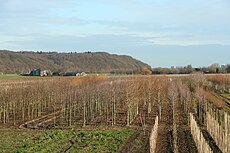Grebbeberg
| Battle of the Grebbeberg | |||||||
|---|---|---|---|---|---|---|---|
| Part of Battle of the Netherlands | |||||||
 The Grebbeberg, seen from the south |
|||||||
|
|||||||
| Belligerents | |||||||
|
|
|
||||||
| Commanders and leaders | |||||||
|
|
|
||||||
| Strength | |||||||
| ca. 15,000 men, 1 division, 1 brigade | 23,000 men, 1 division, 1 brigade | ||||||
| Casualties and losses | |||||||
| 417 KIA | 275 KIA | ||||||
The Battle of the Grebbeberg (Dutch: Slag om de Grebbeberg) was a major engagement during the Battle of the Netherlands, which was a part of the World War II Operation Fall Gelb in 1940.
In the 1930s, the Dutch government pursued a policy of strict neutrality. After World War I, the Dutch parliament supported a disarmament policy because it was generally thought that World War I had been "the war to end all wars". When the threat of Nazi Germany became more apparent the Dutch government decided to reinforce and retrain their Armed Forces. In case of a violation of neutrality by Germany, the strategy of the Army Command was to fall back on the Water Line, which formed part of Fortress Holland, the Dutch national redoubt and to await Allied assistance from France and the United Kingdom. To defend the redoubt, it was necessary to slow the German advance down in order to give as many Dutch forces as possible the chance of assembling in Fortress Holland. To this effect, several defensive lines had been constructed throughout the country. The Maas Line and the IJssel Line had been constructed along the Maas and IJssel rivers and served to detect German incursions into Dutch territory and to delay the Germans in the first hours of an invasion. The fortress at Kornwerderzand on the narrow Afsluitdijk guarded the northern approach to Fortress Holland while the Peel-Raam Line in North Brabant guarded the southern approach. Any attempt to approach Fortress Holland through the central part of the country would be delayed at the Grebbe line. At the beginning of 1940, Chief of Staff General Henri Winkelman redesignated the Grebbe Line the Main Defence Line, because defending the East Front of Fortress Holland would bring the major city of Utrecht into the frontline and the enemy too close to the Dutch capital Amsterdam.
...
Wikipedia
